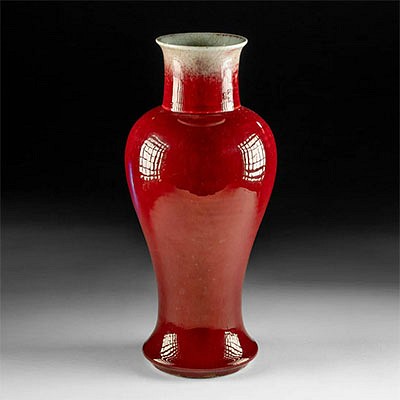Maya Tripod Bowl w/ Dignitary, Glyphs, Kill Hole
Lot 243
About Seller
Artemis Fine Arts
686 S Taylor Ave, Ste 106
Louisville, CO 80027
United States
Selling antiquities, ancient and ethnographic art online since 1993, Artemis Gallery specializes in Classical Antiquities (Egyptian, Greek, Roman, Near Eastern), Asian, Pre-Columbian, African / Tribal / Oceanographic art. Our extensive inventory includes pottery, stone, metal, wood, glass and textil...Read more
Categories
Estimate:
$3,600 - $5,400
Absentee vs Live bid
Two ways to bid:
- Leave a max absentee bid and the platform will bid on your behalf up to your maximum bid during the live auction.
- Bid live during the auction and your bids will be submitted real-time to the auctioneer.
Bid Increments
| Price | Bid Increment |
|---|---|
| $0 | $25 |
| $300 | $50 |
| $1,000 | $100 |
| $2,000 | $250 |
| $5,000 | $500 |
| $10,000 | $1,000 |
| $20,000 | $2,500 |
| $50,000 | $5,000 |
| $100,000 | $10,000 |
| $200,000 | $20,000 |
About Auction
By Artemis Fine Arts
May 11, 2023
Set Reminder
2023-05-11 10:00:00
2023-05-11 10:00:00
America/New_York
Bidsquare
Bidsquare : Fine Antiquities, Asian, Pre-Columbian, Ethnographic Art
https://www.bidsquare.com/auctions/artemis-gallery/fine-antiquities-asian-pre-columbian-ethnographic-art-12771
Classical antiquities, ancient and ethnographic art from cultures encompassing the globe. Artemis Fine Arts info@artemisgallery.com
Classical antiquities, ancient and ethnographic art from cultures encompassing the globe. Artemis Fine Arts info@artemisgallery.com
- Lot Description
**Originally Listed At $2000**
Pre-Columbian, Highlands (Chiapas, Mexico, Guatemala, Honduras, and El Salvador), Maya Late Classic Period, ca. 500 to 800 CE. A fabulous pottery tripod dish boasting the tondo of a seated dignitary and a ceremonial kill hole at the center. Hair pulled back by an elaborate, plumed headdress, the royal sits cross legged atop of platform and looks left, gesturing with one arm held straight outward and the other bent at the elbow. He is bare-chested, wearing only a loincloth, yet still heavily adorned with bangles, earspools and a beaded necklace. His determined countenance is classically Mayan, with a prominent nose and long, sloping forehead, representing beauty ideals that real Mayan lords may have cosmetically altered themselves to achieve. A glyph of 4 circles is painted before him, and a second symbol of a ring with extending lines is featured behind his head. Around the gently sloping rim is a series of glyphs, likely dedicating the vessel, while all is supported by 3 petite feet that previously held rattles. Size: 12.6" Diameter x 3" H (32 cm x 7.6 cm)
Elaborate plates like this one were designed to be instantly distinguishable from those used for everyday eating or drinking - not just in decoration, but also in quantity produced, making these a much rarer find than a piece of domestic pottery. Instead, a bowl like this one would be ritually "sacrificed" by having a hole put through its center, as seen in this example. It would then be placed into a tomb as an offering.
For the Maya, extraordinary ceramic items like this plate were gifted to elite individuals, akin to the gifts exchanged between high profile dignitaries today. Plates were a functional gift, their iconography created by artist/scribes who came from elite families and who took pains to recreate the stories of Mayan mythology and religion as well as to depict royal and godly personages in their artwork. These depictions reinforced the ruling ideology and reminded the viewer of what was valuable in Mayan society. Today, they teach us about the stories that were important to the Maya and also give us clues to how elite people lived and dressed. Scholars have painstakingly worked to decipher the meaning of the iconography and glyphs painted on cylinder jars and we know much more about them than we did even twenty years ago.
PLEASE NOTE: Due to recent increases of shipments being seized by Australian & German customs (even for items with pre-UNESCO provenance), we will no longer ship most antiquities and ancient Chinese art to Australia & Germany. For categories of items that are acceptable to ship to Australia or Germany, please contact us directly or work with your local customs brokerage firm.
Provenance: ex-private Orlando, Florida, USA collection; ex-Arte Primitivo, New York, New York, USA, March 6th, 2020, lot 96; ex-private Florida, USA collection; ex-Barry Kernerman collection, Toronto, Canada; ex-Samuel Dubiner collection, Tel Aviv, Israel, acquired in the 1960s
All items legal to buy/sell under U.S. Statute covering cultural patrimony Code 2600, CHAPTER 14, and are guaranteed to be as described or your money back.
A Certificate of Authenticity will accompany all winning bids.
We ship worldwide and handle all shipping in-house for your convenience.
#176682Professionally repaired with restoration over most break lines and some areas of inpainting to decoration. Expected surface wear commensurate with age, as shown. Otherwise, excellent with nice preservation of pigments and detail. Old Arte Primitivo collection label on underside.Condition
- Shipping Info
-
All shipping is handled in-house for your convenience. Your invoice from Artemis Gallery will include shipping calculation instructions. If in doubt, please inquire BEFORE bidding for estimated shipping costs for individual items. In most cases Artemis Gallery cannot ship to Australia and Germany, please inquire before bidding.
-
- Buyer's Premium



 EUR
EUR CAD
CAD AUD
AUD GBP
GBP MXN
MXN HKD
HKD CNY
CNY MYR
MYR SEK
SEK SGD
SGD CHF
CHF THB
THB















